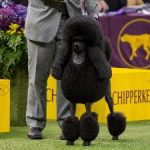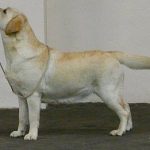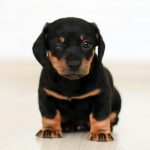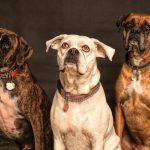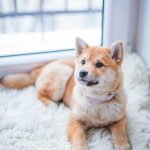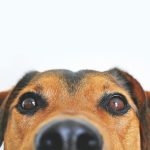
YORKSHIRE TERRIER – feisty, lovable little guy
The breed of imaginative dogs has quite a complex history. Various sources agree that the progenitors of the modern yorkie appeared in Yorkshire and Lancashire as a result of crosses between Scottish terriers. Among the significant ancestors of the yorkshire terrier is mentioned the waterside terrier. This small dog was used as a rat catcher on shipping boats. There is a presumption that the admixture of waterside terrier blood gave the yorkie miniature size, long coat and also blue-grey colouring.
In order to maintain silky hair and also miniaturization, some sources indicate crossbreeding of Yorkies with Maltese. British Kennel Club recognized the breed in 1886. Yorkies owe their popularity to the excellent communication with the broadly understood environment on both two and four legs. One should remember that we are dealing with a terrier with a hunting instinct. Good sense of smell allowed this little one to successfully traverse rabbit burrows. A four-legged dog that could hunt a rabbit was prized in poor working-class England. Yorkies were also used for rat extermination, hunting small rodents. In industrialized, 19th century metropolitan areas, in the absence of organized garbage collection, rat infestation was common. Nowadays the main vocation of our hero is to be a couch cuddler. This small, approx. 3 kg (and there are even smaller), nice figure, feels great on the lap of his lady or gentleman. Does not mean that the yorkie is a phlegmatic safandu³a. On the contrary, it is an active dog full of temperament called „with an unruly broom". Especially ladies like the company of yorkie.
Attention. A dog as a mascot or an accessory that goes with a hat, handbag or shoes is a testimony to a complete misunderstanding. An animal whose domain is activity, movement, when it is almost constantly carried in a bag or on hands, will become a nuisance to the environment. It will discharge its accumulated energy by biting shoes, furniture or rubbing its beloved hat „ladies". Therefore, yorkie, for our and his good, must not be treated like a teddy bear. A daily dose of exercise is necessary, but each side of the leash must walk on its own feet. Unloading energy through a walk, playing, is a condition for a nice composition, calm, not noisy dog.
How far these dogs are sought after, popular, indicates the scale of demand. Well, in the Warsaw branch of the Kennel Club, at one time, the number of litters yorkshire terriers beat all other breeds of dogs. Issued annually tattoo numbers exceeded 1000! In many European countries, and not only, there are a few thousand of them every year. The breed was officially recognized in the nineteenth century, but its particularly rapid development occurred in the second half of the twentieth century. Hans Räber reports that in 1961 alone 2361 Yorkies were sold in England (abroad). Huge sums of money were paid for show winners, especially by the Americans and Japanese. The growing popularity and the mass demand that followed encouraged not so much the development of breeding as the production of the dogs of the mentioned breed. In Poland this phenomenon also occurs. A circumstance conducive to clandestine street trade is the small size of the dog, which can be easily hidden behind the bosom.
A curiosity of the breed is quite a complex coat. E.g. „coat" yorkie should be steel-dark blue (not black). Puppies of this breed are born black, regardless of the genotype (GG, Gg, gg). Grey colouring of the coat, in different shades, takes place during the months of puppy’s maturity, but only in specimens of the first two genotypes. A dominant gene is responsible for this „G". Gene „g" in a homozygous system does not cause greying. Therefore, buying a yorkie with a view to show success, it is good to know the ancestors of the puppy and the occurring in the breeding line transmission.
Toileting a yorkie, keeping its coat in good condition is a whole philosophy. Observance of all rules connected with good appearance of this dog is a must. Groomed York looks exceptionally beautiful and vice versa – a dirty, smelly, disheveled york is a real nightmare. In the case of a domestic dog, the minimum necessary care is enough, while a show dog is a life in papillotes, with constant control of the coat. Combing, bathing, systematic hair trimming with proper care to improve any weak coat. Brush, comb, oil, papillote, proper parting, and on top of the head "topknot", i.e. a knotted pony. The process of preparing a yorkie for show life begins quite early. already 5-6 months old puppies are combed back the hair on the forehead sprinkled with olive oil. After a few months, when the hair grows, will be in this place tied the appropriate bow. This is just a small detail of the whole ritual connected with the show ceremonial. Of course, a whole range of cosmetics is necessary. Good preparation of a yorkie for a show requires knowledge and is not a simple procedure. Therefore, it is advisable to contact the breed section of the Polish Kennel Club and the circle of people who have expert knowledge about the maintenance and proper preparation of a dog of this breed.
From general information it is worth to remember: ubiquity and energy of this dog can be a reason of different situations. Not running yorkie can unload energy m.in . by digging in the garden or biting the furniture. The mentioned activity in combination with the initiative can lead to a total doggy nap. Therefore, it is advisable to control the hygiene of coat and bath at least every 3-4 weeks. It is better to avoid the situation where a neglected long hair can smell not very pleasant. The York, like other small dogs, does not eat much. But the food should be intensive, carefully chosen and contain all the necessary ingredients for health and growth.
The living space of a yorkie can be limited to the size of the place occupied by its master. It is important to organize a good bed. Properly sized, softly padded basket, kennel, located in a secluded place. The dog feels best in the direct company of its owner. Easily adapts to the situation. Is a strategist, can be persistent, a bit hysterical. Therefore, do not forget about the indicated walks, which is a condition of good physical and mental condition of the little one. Like any other dog, a yorkie that is well exercised will behave calmly and not noisily. If necessary, physiological issues can be solved by using a litter box with sand.
Dealing with a yorkie requires calm firmness and consistency. This energetic and clever dog can „enter the head". That’s why you shouldn’t succumb to his charming faces and forgive him everything. This does not mean brutalizing the relationship. It is about controlling the yorkie, developing obedience and not allowing the dog to rule in the house.
Some elements of the breed standard, FCI No. 86, fragments):
Head: the skull should be rather small and flat, there should be no prominence or roundness.
Body: compact, straight back.
Hair coat: the hair on the body is of medium length, completely straight (not wavy), shiny, delicate and silky to touch, it cannot be woolly. The crown of the head is long, in a juicy golden shade, on the sides of the head darker, as well as at the base of the ears and on the muzzle, where the hair should be very long. The head should not overlap the neck. There should be no dark or gray hairs mixed with the golden coat. osmolenia .
Coat colour: dark steel blue, not blue and silver. the coat covers the body from the occipital bone to the base of the tail, there should be no traces of fawn, brown hair or dark patches on it. On the chest the coat is intensely tan (fawn), shiny. in general, fawn hair is darker at the root than in the middle of its length and still shinier at the tips.
Body weight: up to 3.1 kg.
Height: 22-24 cm at withers.
Behaviour/character: miniature companion terrier, lively and intelligent. Full of animation, with a balanced disposition.
